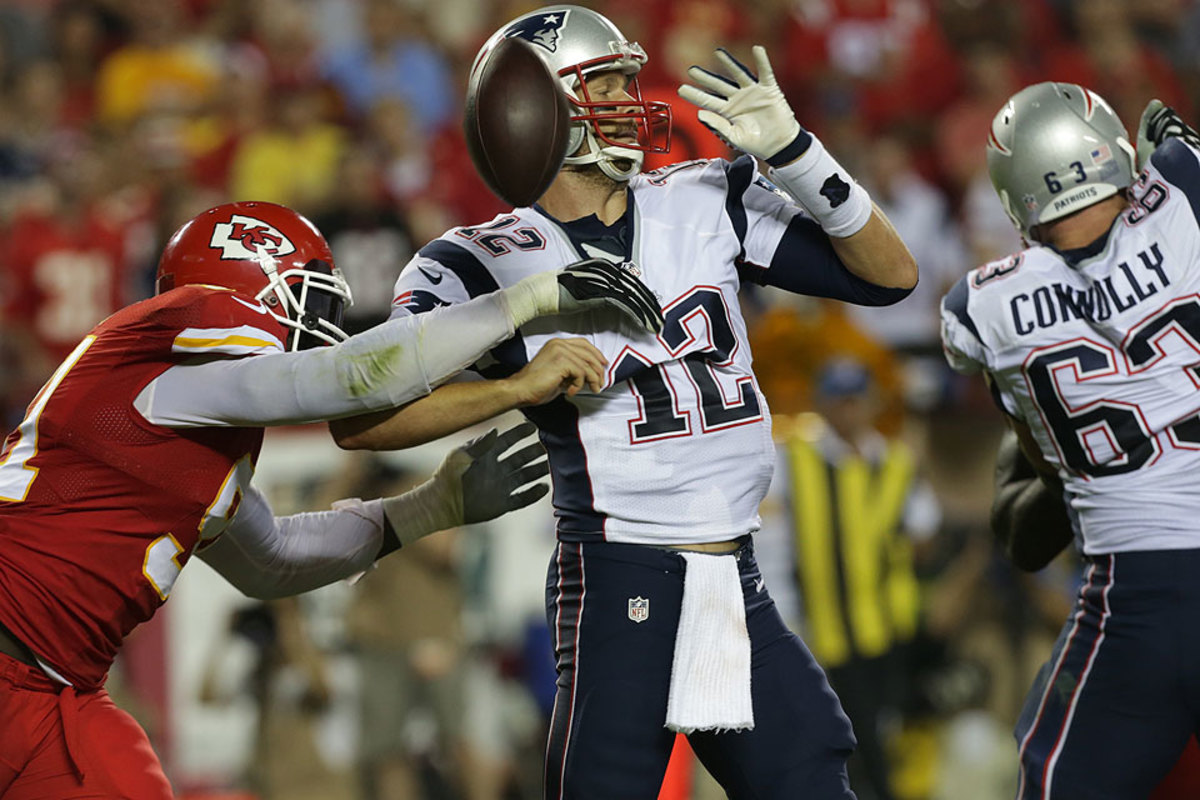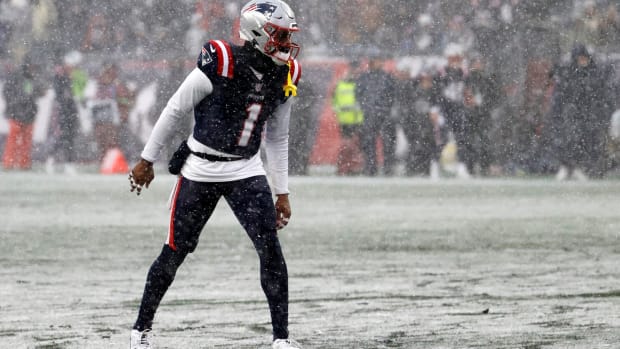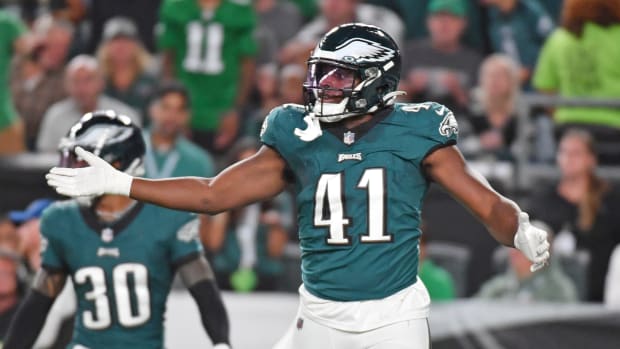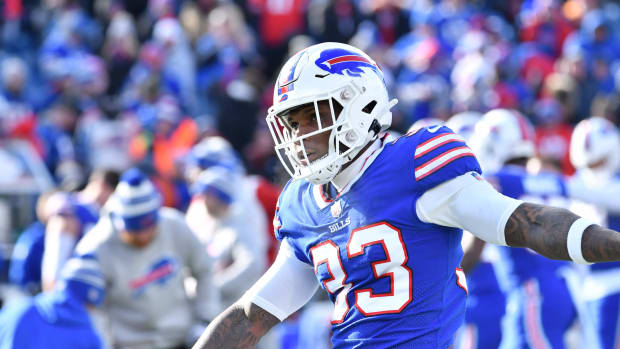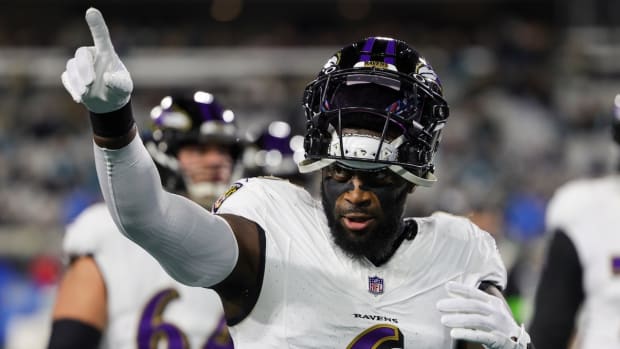What's Wrong With Pats? Plenty, But It Can Be Fixed
What's wrong with the Patriots? First thing first: any talk about this team being washed up or needing a quarterback change or compromising itself by not signing any big-time wide receivers is so knee-jerkingly reactionary that we’re not going to dignify it with elaboration. We’re four games into a long season; New England’s problems right now are micro, not macro.
On defense, the Patriots are a good team coming off a bad game. The Chiefs, per usual, had some excellent misdirection designs in their running game, which naturally exploited the Patriots’ man coverage foundation on Monday night. When you run misdirection against man-to-man, defenders are compelled to follow the fake. It was a great game plan by Andy Reid; Bill Belichick will have to address the weaknesses it exposed.
But the defense will be fine, especially with cornerback Brandon Browner now coming back after a four-game suspension.
The offense, on the other hand, is grossly out of sync. It starts with the front five. The Patriots made personnel changes at all five O-line positions throughout Monday night. Most of them—like benching left tackle Nate Solder—won’t stick. But it takes horrendous play to inspire such drastic in-game adjustments. You could argue that every Patriots offensive lineman is having his worst season as a pro. The headliner, Solder, certainly is.
It’s hard to say what’s propagating the struggles up front. But one has to figure the retirement of venerated 15-year line coach Dante Scarnecchhia is a factor. The Logan Mankins trade didn’t help, though there’s overwhelming evidence from last year’s film that Mankins, had he not been traded to Tampa Bay in late August, would have simply been part of these problems rather than a solution to them. The 32-year-old was slowing down in pass protection.
New England's skill position players, like Shane Vereen, haven't found much space to operate this season. (Dilip Vishwanat/Getty Images)
The problem with bad pass protection is the quarterback knows it’s bad and, human nature being what it is, starts to speed up his play. Tom Brady has done that. He even did it against Miami which, considering it was Week 1, tells you there had been protection problems in practice.
The Patriots mostly use a short-drop passing attack, so it seems intuitive that it’s not exactly bad for a quarterback to speed up. But it doesn’t work that way. Speeding up means distorting the synchronization of route concepts. The Patriots’ passing game hinges on that synchronization.
A short-drop passing game also hinges on having the full breadth of eligible receivers running routes. That means you’re not holding back tight ends and running backs as full-time helpers in pass protection, so the struggling linemen are stuck in one-on-one scenarios. Typically that’s fine because the ball comes out quickly. But this line has been screwing up even before the ball can come out (which is hard to do). And the Patriots receivers have not been winning battles off the line of scrimmage.
Which gets into the last issue: the receivers. Danny Amendola has been a nonfactor. So have youngster Kenbrell Thompkins and Aaron Dobson (both were healthy scratches Monday night). But the Patriots passing game is about creating mismatches for Julian Edelman, Rob Gronkowski and Shane Vereen anyway. That hasn’t happened as much this season, perhaps due to Gronk being slowly worked back from his knee injury. Edelman is productive inside, where he can often match up against linebackers and safeties. But outside is a different story, especially against lanky corners like Kansas City’s Sean Smith. Vereen is the surprising one. He has caught four or five balls in each game (save for the Minnesota game, when he caught zero), but those touches have not felt central to the offense’s attack. When this offense was at its best last season, Vereen was motioning in and out of the backfield, creating field-altering matchup problems. This year, he’s been almost an afterthought.
The good news is that all of this is correctable. And we’ve seen the Patriots make sweeping midseason schematic changes before. The guess here: at some point Vereen will be featured more, and so will backup tight end Tim Wright, who was acquired from Tampa Bay as part of the Mankins trade. Wright has unique fluidity as a pass-catching tight end. That’s a great tool for creating matchup problems, which the Patriots need to start doing since matchup problems are what’s hurting their linemen and wide receivers right now.
The Two Best-Coached Defenses in Football
The Cardinals and Bengals, coming off byes, are the NFL’s only remaining unbeatens. Both are stepping into their brightest spotlight of this young season, as Arizona's game at Denver is the national FOX game Sunday afternoon and the Bengals are traveling to Foxboro for Sunday Night Football.
More on Cards
How has coordinator Todd Bowles kept the depleted Arizona defense performing at a high level? Peter King explores. FULL STORY
Getting to know these two teams and understanding why they’re undefeated calls for an examination of their defenses, which rank first and second in points allowed per game (Cincinnati 11.2, Arizona 15.0).
These aren’t the two most talented defenses in the league. In fact, both lost key components this offseason. Bengals defensive end Michael Johnson signed with Tampa Bay and esteemed coordinator Mike Zimmer left for Minnesota. The Cardinals, for a variety of reasons, have lost a bevy of stars: inside linebackers Karlos Dansby and Daryl Washington, defensive tackle Darnell Dockett, edge-rusher John Abraham and, up until this week, they’ve mostly been without star Swiss Army Knife defensive back Tyrann Mathieu.
A rule of thumb you’ve probably read here before: the less talent you have, the more dependent you are on scheme. In terms of tactically conjuring advantageous situations, these two teams have the two best defensive schemes football. (The Seahawks still have the league’s best defense overall, but their scheme is straightforward and centers around their wealth of star players.)
Defensive coordinators Paul Guenther (Cincy) and Todd Bowles (Arizona) have done marvelous work. Guenther runs a 4-3 base, while Bowles runs a 3-4. But in critical passing situations – where the vast majority of NFL games are decided – they both adhere to the same core principle: double-A-gap pressure.
Jumping out on film
The best inside linebacker in football this season has been Detroit’s DeAndre Levy—by far. The fifth-year pro has astounding speed and fluidity, and he’s learned to capitalize on it by recognizing play structures presnap and angles to the ball postsnap. Now Levy will have to carry a heavier load with middle linebacker Stephen Tulloch out. Levy did well with that last Sunday against the Jets, and Tulloch’s replacement, Tahir Whitehead, played very well.
• ROBERT KLEMKO: DeAndre Levy is new breed of linebacker
Smart watching for Week 5
This could be a tough week for the Eagles. Yes, they’re at home against a mediocre Rams team, but this offense does not match up well to St. Louis’s defense. With left guard Evan Mathis and center Jason Kelce out, the interior O-line lacks the athleticism that’s critical for space-oriented run designs and screens (both with backs and receivers), which define much of Chip Kelly’s system. LeSean McCoy’s putrid production the past two weeks serves as glaring evidence. Even with Chris Long out, the Rams have the most athletic front four in football. If their young secondary, which is inconsistent but capable in man coverage, can be comfortable against Philly’s unfamiliar spreads and tempo, this will be a tight game Sunday.
Impressive Coaching
We can’t call Dennis Allen’s 8-28 coaching job in Oakland “impressive,” but we can shed light on the fact that Allen’s record, for all intents and purposes, is really just 0-4. His first two seasons he coached a Raiders club mired by salary cap woes. It was well-known from Day 1 of the Reggie McKenzie/Dennis Allen era that this team had little chance at being competitive until Year 3. Four games apparently is enough for Mark Davis to make a change. And yes, this has to be Mark Davis’s change, either directly or indirectly by having McKenzie on the hot seat. Allen was never able to feel comfortable with his job status, and that impacted his coaching decisions, including big ones like who got reps at quarterback. (You really think any coaching staff would 100 percent willingly elect to play Terrelle Pryor, a quarterback who could neither read defenses nor throw?) It’s the same old Raiders, just under a different-named Davis.
On the podcast this week
Available on Thursday, we analyze Week 5, propping up all the overlooked storylines and shooting downs the overhyped ones. Plus, Ravens tight end Owen Daniels will tell us why Gary Kubiak’s passing game this year has looked different than it did in Houston.
10 film study quick-hitters
An ankle injury has slowed Calvin Johnson this season. (Gregory Shamus/Getty Images)
1. If Levy has been the league’s best inside linebacker so far, then New Orleans’s Curtis Lofton is second best (although he didn’t have a particularly impressive showing at Dallas last week).
2. Raiders rookie QB Derek Carr has shown an intriguing skill set and his understanding of defenses isn’t bad. However, one concern (in addition to his current knee injury) is that he tends to cover too much ground in the pocket while moving through his progression. That can make him slow to reset and fire.
3. Calvin Johnson was clearly not 100 percent last week. In Weeks 2 and 3, when he was healthy, he caught six balls for a little over 80 yards in each game. Not bad, but not great considering that he saw straight single-high zone coverage, not double teams.
4. As a pure runner, Kansas City’s Knile Davis can be a top-five back.
5. Big concern for Washington’s defense: the number of times offenses have capitalized on having a tight slot receiver matched against linebacker Perry Riley.
6. Alshon Jeffery and Brandon Marshall are both great blockers. A lot of the Bears’ outside running designs rely on that.
7. By his high standards, Texans left tackle Duane Brown has had a little trouble with speed rushers this season.
• PETER KING: Watching film with San Diego's Dwight Freeney
8. EJ Manuel’s only negative on film has been poor accuracy. But that’s a big negative. In benching him, Doug Marrone has tacitly declared he doesn’t think his young QB can sort that out quickly enough to save everyone’s jobs.
9. J.J. Watt’s best trait: his lateral movement (burst, really) off the ball.
10. Lost in the euphoria of Green Bay’s turnaround: the fact that its run defense just gave up 235 yards to the Bears. It’s just the third time in the modern era that a team has won by 21 or more points while surrendering at least 235 yards on the ground.
































